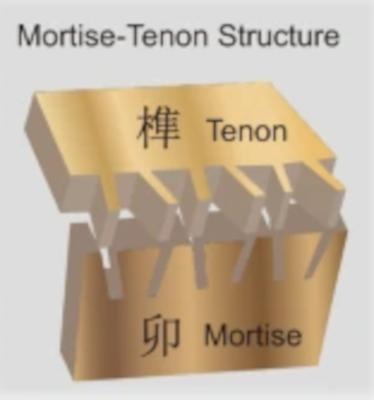Researchers from Nanjing Tech University, Wuhan University of Technology and National University of Singapore set out to address two major issues that should be resolved in order to promote perovskite solar cells (PSCs): disorder crystallization of perovskite and unbalanced interface charge extraction, which limit further improvements in device efficiency.
The team used a thermally polymerized additive N-vinyl-2-pyrrolidone (NVP) as a polymer template in the perovskite film, followed by a conventional HTL/Chlorobenzene (CB) solution spin-coating process to remove the residual miscellaneous phases and open the grain boundaries to form monolithic perovskite grains, thereby suppressing the defect-related non-radiative recombination. Furthermore, this process results in the formation of a novel “Mortise-Tenon” (M-T) structure for perovskite/HTL composite film, which provides a larger contact area between perovskite and HTL, thereby facilitating hole extraction to achieve balanced charge management.
M-T structures are commonly used in woodworking for strong connections between different materials, providing resistance to twisting. In the proposed configuration, the M-T structure consists of the perovskite absorber and a thermally polymerized additive called N-vinyl-2-pyrrolidone (NVP) used for the hole transport layer (HTL).
According to the scientists, NVP maintains a strong interaction with perovskite precursors during the spin-coating process, resulting in improved charge transport and high-quality perovskite/NVP films.
The cell design includes a glass/fluorine-doped tin oxide (FTO) substrate, SnO2-based HTM, perovskite absorber with NVP, spiro-OMeTAD layer, and a gold (Au) metal contact.
Comparing the device performance to a reference cell, the champion device achieved a power conversion efficiency of 24.55%, an open-circuit voltage of 1.187 V, a short-circuit current density of 25.66 mA cm−2, and a fill factor of 80.64%. The researchers emphasized the benefits of suppressed non-radiative recombination and balanced interface charge extraction due to high-quality perovskite crystals and the Mortise-Tenon structure. In contrast, the reference device achieved an efficiency of 22.91%, an open-circuit voltage of 1.151 V, a short-circuit current density of 25.21 mA cm−2, and a fill factor of 78.94%.
Additionally, the cell with the M-T structure demonstrated excellent durability, retaining over 95% of its initial efficiency for 1100 hours. The device underwent measurement and certification at the Quality Testing Center for Photovoltaic and Wind Power Systems of the Chinese Academy of Sciences.
“Our work highlights the role of increasing the contact area of perovskite layer and HTL and proposes a unique strategy to realize interfacial charge-extracting balance in perovskite solar cells, which may be an important approach to achieve efficient device in the future,” they concluded.
